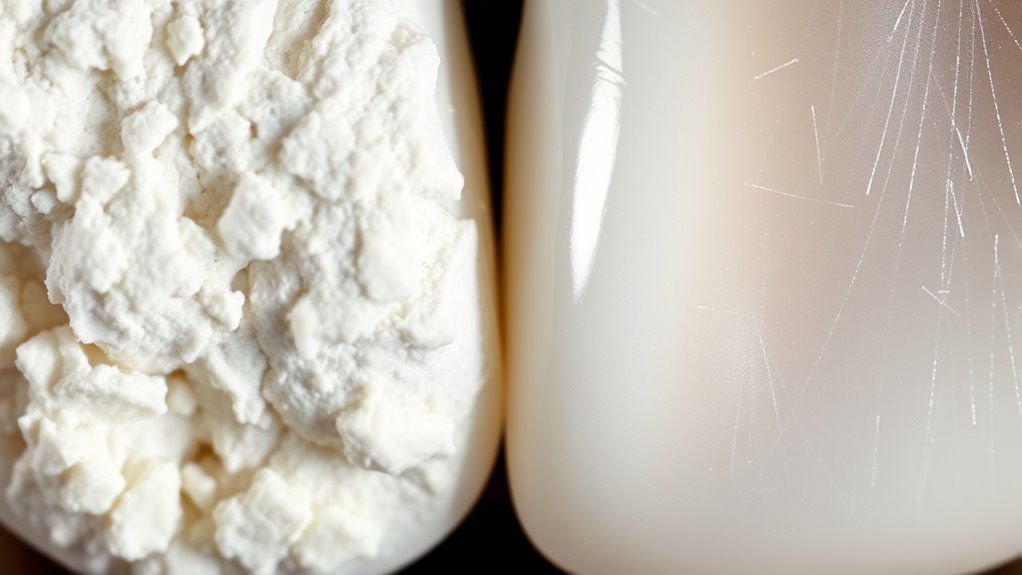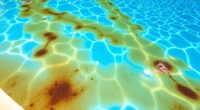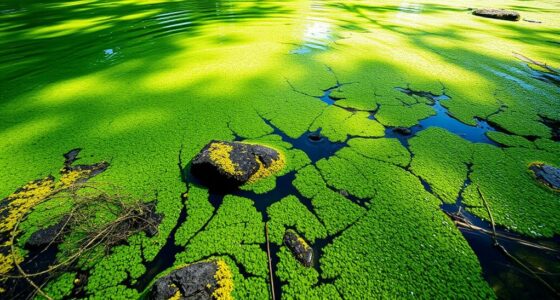To spot the difference between calcium scaling and surface etching, look closely at the surface: calcium buildup appears as white, crusty deposits that feel rough, while etching results in dull, smooth patches with fine lines, caused by chemical reactions. Calcium deposits are easier to remove with gentle scrubbing, but etching often needs professional repair. Understanding these signs helps you decide on the right fix—explore further to protect your surfaces effectively.
Key Takeaways
- Calcium scaling appears as white, crusty deposits; etching shows smooth, dull, or frosted surface patches.
- Scaling is caused by mineral deposits; etching results from chemical or acid corrosion damaging the surface.
- Buildup feels rough and abrasive; etched areas are softer, with fine lines or matte texture.
- Diagnosing involves visual inspection and water chemistry testing for mineral content and pH levels.
- Fixing scaling requires gentle cleaning or descaling; etching may need surface repair or protective coatings.
What Is Calcium Scaling and How Does It Form?
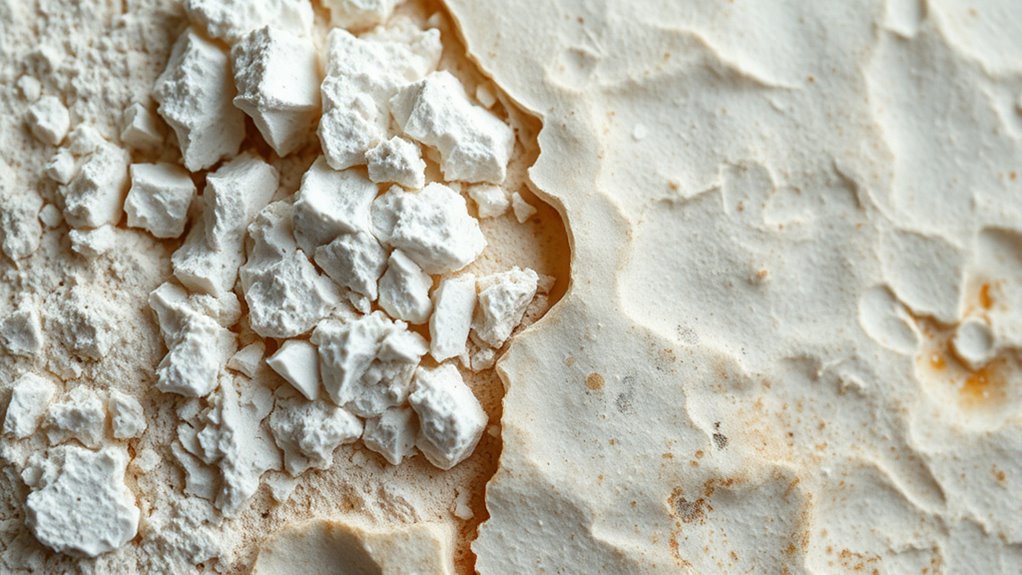
Calcium scaling occurs when dissolved calcium minerals in water deposit onto surfaces, forming hard, chalky layers. When water with high calcium content, like hard water, flows over fixtures or inside pipes, calcium salts start to settle out as the water cools or evaporates. This buildup often appears as white, crusty deposits on faucets, showerheads, and inside appliances. Over time, these deposits can grow thicker, restricting water flow and reducing efficiency. The process is influenced by factors such as water temperature, pressure, and mineral concentration. Calcium scaling is a natural result of mineral-rich water interacting with surfaces, especially when water isn’t regularly flushed or cleaned. Recognizing these deposits early helps prevent more significant issues and keeps your plumbing functioning smoothly. Understanding mineral deposits can help in choosing the right treatment and prevention methods.
Understanding the Process of Surface Etching

Surface etching occurs when aggressive substances, like acids or corrosive chemicals, interact with material surfaces, causing them to deteriorate at a microscopic level. You might notice this process happening when a chemical reacts with the surface, breaking down the bonds that hold the material together. Unlike surface buildup, etching involves material loss, creating tiny grooves or rough patches. The acids or chemicals attack specific components, often targeting minerals within the surface, leading to a controlled erosion. This process is common in industrial cleaning, manufacturing, and even in natural environments where acidic rain or pollution accelerates material breakdown. Understanding how etching occurs helps you identify whether the surface has been chemically altered or damaged, enabling you to choose the right approach for cleaning or restoration. Mindfulness techniques can also help in managing stress caused by surface deterioration concerns, promoting a calm and focused approach to repairs and maintenance.
Visual Differences Between Calcium Buildup and Etched Surfaces
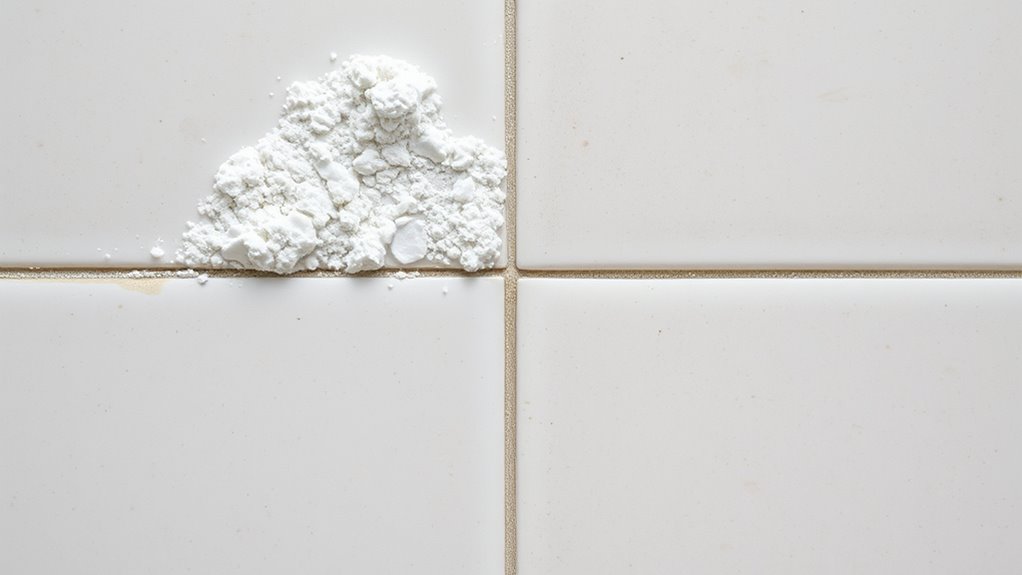
While calcium buildup and etched surfaces may look similar at first glance, their visual differences are quite distinct once you observe closely. Calcium deposits tend to appear as white, chalky, or crusty layers that form uneven patches on the surface. They often create a rough, gritty texture that feels abrasive to touch. In contrast, etched surfaces have a smoother, often matte appearance with subtle, irregular patterns caused by material removal. The etching creates fine lines or frosted areas that lack the bulky, solid buildup characteristic of calcium deposits. You might notice that calcium buildup is more prominent in corners or crevices, whereas etching tends to be more uniform or localized to specific zones. Recognizing these differences helps you diagnose the issue more accurately. Additionally, understanding the visual cues can prevent unnecessary repairs or replacements.
Common Causes and Conditions Leading to Each Issue
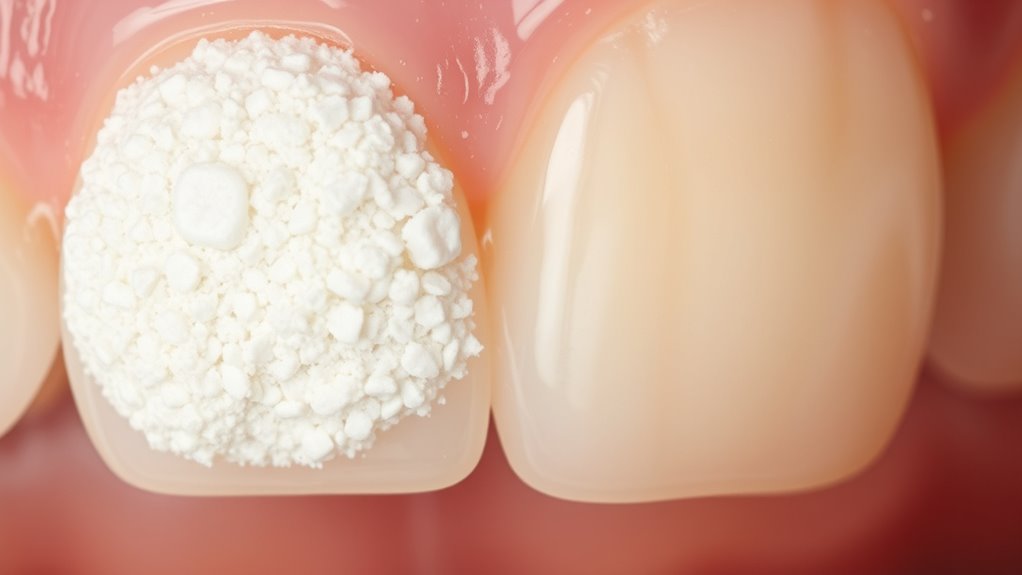
Hard water deposits form when minerals like calcium and magnesium settle out of mineral-rich water, leading to scaling. Corrosive water conditions, often caused by low pH or high chlorides, can damage surfaces and cause etching. Understanding these causes helps you prevent both buildup and surface deterioration effectively. Regular assessment and rotation of items can also contribute to maintaining overall surface integrity by ensuring that surfaces are kept clean and free from mineral buildup or corrosive elements.
Hard Water Deposits Formation
Hard water deposits form when minerals like calcium and magnesium dissolved in water accumulate on surfaces over time. When water evaporates from appliances, fixtures, or pipes, these minerals are left behind, creating a stubborn buildup. You’ll notice white, chalky deposits on showerheads, faucets, and tiles, especially in areas with hard water. Factors like high mineral content in your water supply and frequent use of hot water accelerate this process. Poor water softening or filtration systems can also contribute, allowing minerals to settle instead of being removed. Over time, these deposits can clog pipes and reduce appliance efficiency. The key cause is sustained contact between mineral-rich water and surfaces, leading to persistent mineral buildup that’s difficult to remove once established. Additionally, regular maintenance and water testing can help identify hard water issues before significant buildup occurs.
Corrosive Water Conditions
Have you ever wondered what causes water to become corrosive and damage your plumbing? Corrosive water results from high acidity, low pH, or elevated levels of dissolved oxygen. These conditions accelerate metal pipe deterioration, leading to leaks and failures. Common causes include natural soil acidity, industrial pollutants, and improper water treatment. Understanding these factors helps you identify risks early. Here’s a quick overview:
| Cause | Effect | Result |
|---|---|---|
| Low pH (acidic water) | Corrosion of metal pipes | Leaks, discoloration |
| High dissolved oxygen | Oxidizes pipe material | Pitting, weakening |
| Industrial pollutants | Chemical reactions | Scale buildup, damage |
Addressing water chemistry guarantees your plumbing stays protected and extends its lifespan. Proper water testing and treatment can significantly reduce the risks associated with corrosive water, making water chemistry a crucial aspect of home maintenance.
Methods for Detecting and Diagnosing the Problems
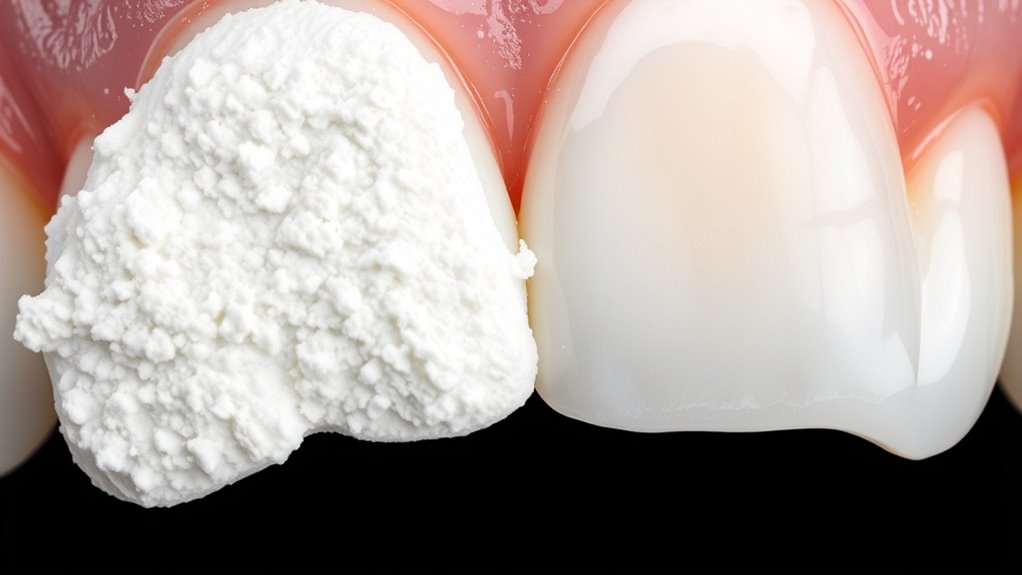
Detecting and diagnosing calcium scaling and etching issues require careful observation and appropriate testing methods. First, examine the affected surfaces closely—calcium deposits often appear as white, crusty buildup, while etching causes smooth, dull spots. Next, perform a simple water test by analyzing water hardness levels; high levels suggest scaling potential. Third, use a flashlight or magnifying glass to check for surface irregularities or dullness indicative of etching. Additionally, understanding water chemistry analysis can provide deeper insights into the underlying causes of these issues. Finally, consult a professional for advanced testing, such as surface analysis or water chemistry assessments, to confirm the problem. By following these steps, you can accurately identify whether calcium scaling or etching is affecting your equipment, ensuring you choose the right solution for effective repair.
Effective Strategies to Remove Calcium Deposits

To effectively remove calcium deposits, start by choosing the right cleaning agents and methods tailored to the severity of the buildup. For light deposits, use vinegar or lemon juice; these natural acids dissolve mineral buildup gently. For heavier deposits, commercial descaling products containing acids like citric or phosphoric acid work better. Mechanical methods, such as scrubbing with a non-abrasive pad or using a plastic scraper, can also help loosen stubborn deposits. Here’s a visual guide:
| Light Deposits | Heavy Deposits |
|---|---|
| Vinegar or lemon juice | Commercial descalers |
| Soaking cloths in natural acids | Mechanical scrubbing |
| Gentle wiping | Using plastic scrapers |
| Rinsing thoroughly | Repeating application |
Choose the appropriate method based on deposit thickness for effective removal. Additionally, understanding the difference between calcium scaling and etching can help you select the proper cleaning technique to prevent surface damage.
Repair and Prevention Tips for Surface Damage

Surface damage from calcium scaling or etching can be minimized by implementing proper repair and prevention measures. First, regularly clean your surfaces with non-abrasive, pH-balanced cleaners to prevent buildup. Second, consider applying a protective sealant or coating that resists mineral deposits and etching. Third, monitor your water quality; using a water softener can reduce calcium levels and prevent scaling. Fourth, address damage early by repairing chips or scratches with appropriate repair kits to prevent worsening. Additionally, understanding juice cleansing effects can inform how dietary choices might influence mineral buildup in water systems. Consistent maintenance and proactive steps are key to preserving surface integrity. By staying vigilant and following these tips, you can avoid costly repairs and keep your surfaces looking their best longer.
Frequently Asked Questions
Can Calcium Scaling and Etching Occur Simultaneously on the Same Surface?
Yes, calcium scaling and etching can occur simultaneously on the same surface. When water contains high mineral levels, calcium deposits may build up in some areas while the surface is being etched or worn away in others. This usually happens if the conditions fluctuate, causing uneven mineral deposition and surface erosion. To fix this, you should clean the surface thoroughly, remove calcium deposits, and adjust water chemistry to prevent further issues.
How Long Does It Typically Take for Calcium Buildup to Become Visible?
Typically, calcium buildup becomes visible within a few weeks to a few months, depending on water hardness and usage. If your water has high mineral content, you might notice deposits forming sooner. Regular inspections help catch it early. You’ll see a chalky or whitish film on surfaces or fixtures, indicating calcium deposits. Staying proactive with maintenance and water treatment can prevent excessive buildup and keep your surfaces clear.
Are There Specific Materials More Prone to Calcium Scaling or Etching?
Certain materials, like glass and ceramic, are more prone to calcium scaling, especially in areas with hard water. Studies show that over 85% of homes with hard water experience calcium buildup on fixtures within a year. You’ll notice that mineral deposits tend to form faster on porous surfaces, making regular cleaning essential. To prevent damage, choose materials resistant to scaling or etching, and consider water softening systems to reduce mineral deposits.
What Are the Environmental Factors That Accelerate Calcium Scaling or Etching?
Environmental factors like high mineral content in water, especially calcium and magnesium, speed up calcium scaling. Hot temperatures also promote this buildup, while prolonged exposure to acidic conditions can cause etching of surfaces. If you notice these conditions, you can reduce scaling and etching by lowering water temperature, installing water softeners, or using protective coatings. Staying aware of these factors helps you prevent damage and maintain your surfaces longer.
Can Regular Maintenance Prevent Both Calcium Scaling and Surface Etching Effectively?
Yes, regular maintenance can effectively prevent both calcium scaling and surface etching. By routinely cleaning your equipment, checking water quality, and using appropriate anti-scaling agents or protective coatings, you reduce mineral buildup and surface damage. Consistent inspections allow you to catch issues early, preventing costly repairs and prolonging equipment lifespan. Staying proactive with maintenance guarantees peak performance and minimizes the risk of calcium-related problems.
Conclusion
By understanding the differences between calcium scaling and etching, you can accurately diagnose and address surface issues. Don’t worry if it seems complicated at first—with the right detection methods and prevention tips, you’ll keep your surfaces in top shape. Remember, ignoring these problems can lead to costly repairs later. Take action now, and you’ll save time and money while maintaining a clean, damage-free surface for years to come.
